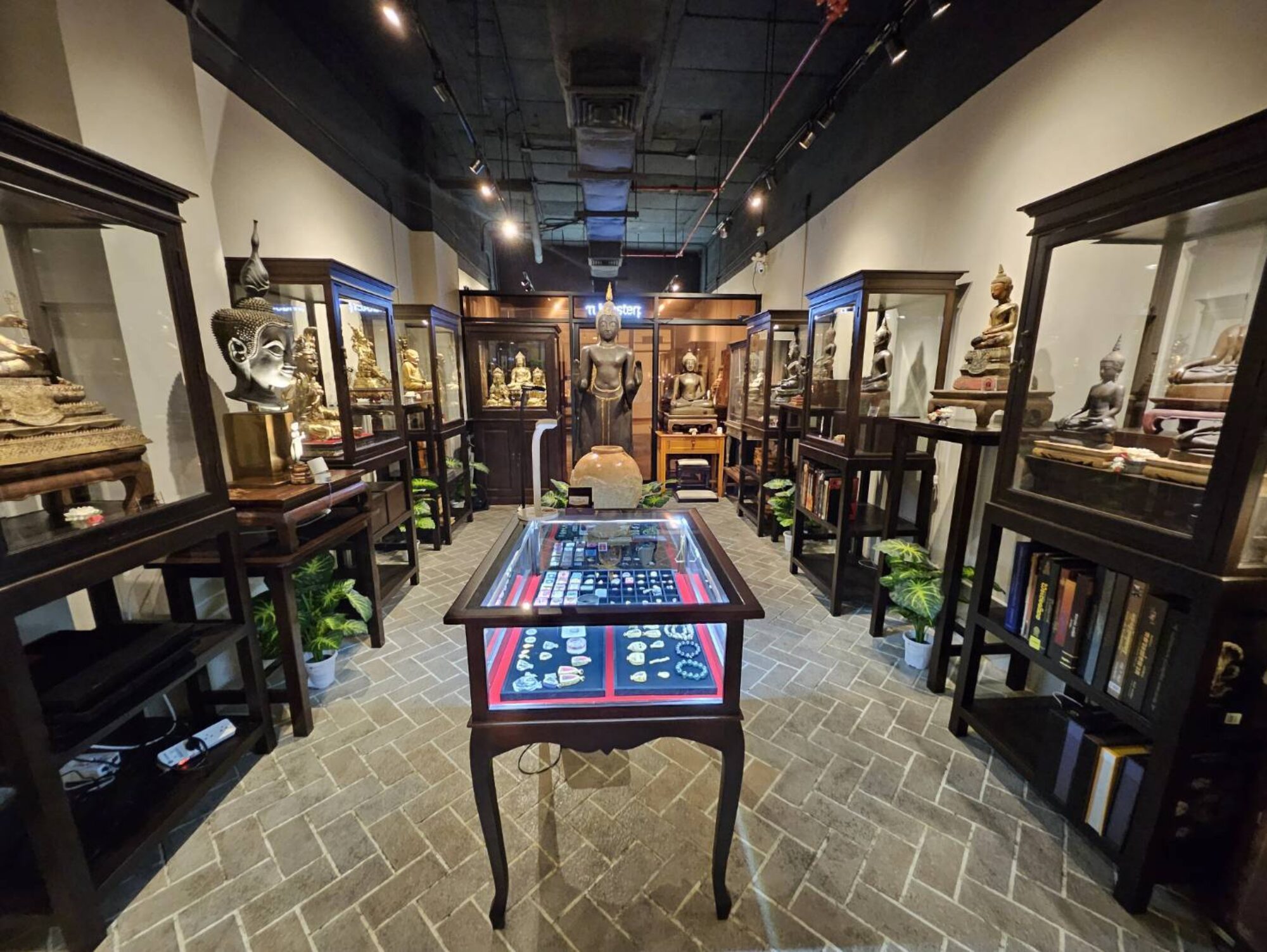
รายละเอียดพระบูชา:
พระบูชาองค์นี้เป็นพระพุทธรูป ปางแสดงธรรม (Vitarka Mudra) สร้างขึ้นใน พ.ศ. 2481 (ค.ศ. 1938) โดย แม่แช่ม ศิลปะการสร้างที่งดงาม เป็นปางที่หายาก และมีความวิจิตรงดงาม สะท้อนถึงศิลปะใน สมัยรัชกาลที่ 7–8 ของกรุงรัตนโกสินทร์
ลักษณะเด่นของพระบูชา:
- พระพักตร์:
- อ่อนโยนและแสดงออกถึงความเมตตา พระโอษฐ์ยิ้มเล็กน้อย สะท้อนถึงความสงบเยือกเย็น
- พระรัศมีเปลวไฟ:
- เป็นเอกลักษณ์แสดงถึงปัญญาที่รุ่งเรืองและความรู้แจ้ง
- ปางแสดงธรรม:
- พระหัตถ์ขวายกขึ้นระดับอก นิ้วโป้งและนิ้วชี้แตะกันเป็นวงกลม หมายถึงการแสดงธรรมและการสอนธรรมะ
- เป็นปางที่หายาก นิยมใช้สื่อถึงการเผยแพร่ธรรมะในหมู่พุทธบริษัท
- ฐานรองรับ:
- เป็นฐานกลีบบัว พร้อมลวดลายธรรมจักรด้านหน้า สื่อถึงการหมุนวงล้อแห่งธรรม
ตำนานและความเชื่อในการสร้าง:
- การสร้างพระบูชาองค์นี้ใน พ.ศ. 2481 เกิดขึ้นในช่วงที่ประเทศไทยเริ่มมีการฟื้นฟูพระพุทธศาสนาอย่างกว้างขวาง พระบูชาสร้างขึ้นเพื่อเฉลิมฉลองความรุ่งเรืองของพระธรรมคำสอน และเสริมความศรัทธาแก่ผู้คน
- ผู้จัดสร้าง (แม่แช่ม): เชื่อกันว่ามีความศรัทธาแรงกล้าและตั้งใจอุทิศตนในการสร้างพระพุทธรูปที่เปี่ยมไปด้วยความศักดิ์สิทธิ์
ยุคสมัย:
- พระบูชาองค์นี้จัดอยู่ในศิลปะ รัตนโกสินทร์ตอนกลาง (รัชกาลที่ 7–8) ซึ่งเป็นยุคที่เน้นความประณีตและการสร้างพระพุทธรูปตามแบบโบราณประเพณี
ความศักดิ์สิทธิ์และศรัทธา:
- เสริมปัญญาและความสำเร็จ:
- เนื่องจากเป็นปางแสดงธรรม สื่อถึงความรู้แจ้งและความเข้าใจในธรรมะ
- เสริมเมตตามหานิยม:
- ส่งเสริมความเมตตาและการสื่อสารที่ดีต่อผู้คน
- คุ้มครองป้องกันภัย:
- เนื้อโลหะนวะถือเป็นโลหะศักดิ์สิทธิ์ เชื่อกันว่าปกป้องเจ้าของจากภยันตราย
- ส่งเสริมความสงบทางจิตใจ:
- เหมาะสำหรับการบูชาเพื่อเจริญสมาธิ และใช้เป็นเครื่องเตือนใจในการดำเนินชีวิตด้วยธรรมะ
บทสรุป:
พระบูชาองค์นี้มีความพิเศษทั้งในด้านวัสดุ นวะโลหะ และปางที่หายากอย่าง ปางแสดงธรรม สร้างขึ้นในยุครัชกาลที่ 7–8 ช่วง พ.ศ. 2481 โดยผู้สร้างที่มีศรัทธาแรงกล้าอย่าง แม่แช่ม เหมาะสำหรับผู้ศรัทธาที่ต้องการเสริมพลังปัญญา ความสำเร็จ ความเมตตา และคุ้มครองป้องกันภัย เป็นพระบูชาที่ทรงคุณค่าทางศิลปะและจิตวิญญาณอย่างแท้จริง
Details of Buddha statue:
This Buddha statue is a Buddha statue in the Dharma Teaching Posture (Vitarka Mudra) created in 1938 by Mae Chaem. The beautiful art of creation is a rare and exquisite posture, reflecting the art of the 7th-8th reign of Rattanakosin.
Distinctive characteristics of the Buddha statue:
Facial expression:
Gentle and expressing compassion, with a slight smile on the lips, reflecting calmness and coolness.
Flame halo:
A unique symbol representing radiant wisdom and enlightenment.
Dharma Teaching Posture:
The right hand is raised to chest level, with the thumb and index finger touching in a circle, meaning the teaching of Dharma and Dharma.
This is a rare posture, popularly used to convey the spread of Dharma among Buddhists.
Base:
A lotus petal base with a Dharmachakra pattern on the front, representing the rotation of the Dharma Wheel.
Legends and beliefs in creation:
This Buddha statue was created in 1938. 2481 occurred during the period when Thailand began to revive Buddhism widely. The Buddha image was created to celebrate the glory of the Dharma teachings and to strengthen people’s faith.
Creator (Mae Cham): It is believed that she had strong faith and was dedicated to creating a Buddha image that was full of sacredness.
Era:
This Buddha image is classified in the art of the middle Rattanakosin period (the reign of King Rama VII-VIII), which is an era that emphasized meticulousness and the creation of Buddha images according to ancient traditions.
Sacredness and faith:
Enhance wisdom and success:
Because it is a Dharma teaching posture, it conveys knowledge and understanding of the Dharma.
Enhance loving-kindness and popularity:
Promote loving-kindness and good communication with people.
Protect from danger:
Nawa metal is considered a sacred metal. It is believed to protect the owner from danger.
Promote peace of mind:
Suitable for worship to develop concentration. And use it as a reminder to live life with Dharma.
Conclusion:
This Buddha image is special in both its materials, Nava Loha, and its rare posture, the Dharma-speaking posture. It was created during the reign of King Rama VII-VIII, around 1938, by a creator with strong faith, Mae Chaem. It is suitable for believers who want to enhance their wisdom and success.
佛像详情:
此佛像是佛陀示现的宣法印像,创作于1400年。 2481(1938 年),Mae Chaem 创作,精美的艺术创作这是一个罕见的姿势。而且它极其美丽。体现拉玛国王统治时期的艺术拉达那哥欣 7-8
佛像的突出特点:
脸:
温柔而富有同情心他嘴角露出一丝微笑。体现冷静
火焰光晕:
它是代表辉煌智慧和启蒙的象征。
宣法姿势:
右手举至胸部高度。拇指和食指互相接触形成一个圆圈。意思是宣扬、教导佛法。
这是一个罕见的姿势。它广泛用于在佛教徒中传达弘扬佛法的信息。
支持基础:
是一個莲花瓣底座。正面有法轮图案指转动法轮。
创世传说与信仰:
此佛像创作于佛历 1866 年。 1938年,正值泰国佛教广泛复兴的时期。这尊佛像是为了颂扬佛法的辉煌而创作的。增强人们的信念
创作者(湄湛):人们相信她有着坚定的信仰,并致力于创造一尊充满神圣性的佛像。
时代:
此佛像属于拉达那哥欣艺术时期中期(拉玛七世至八世统治时期),这一时期注重精致,并按照古老传统创作佛像。
圣洁与信仰:
提高智力和成功率:
因为这是讲法的姿势它传达了对佛法的认识和理解。
提升善良度和人气:
促进善良以及与人良好的沟通。
防范危险:
纳瓦金属被认为是一种神圣的金属。人们相信它可以保护主人免受危险。
促进精神平和:
适合敬拜以培养注意力。并以此提醒自己在生活中践行佛法。
结论:
这尊佛像的特殊之处在于其材质 Nava Loha,以及其罕见的法相姿势。它是在拉玛七世至八世国王统治期间(约 1938 年)由一位信仰坚定的创作者 Mae Chaem 创作的。它适合想要提升智慧和成功的信徒。
